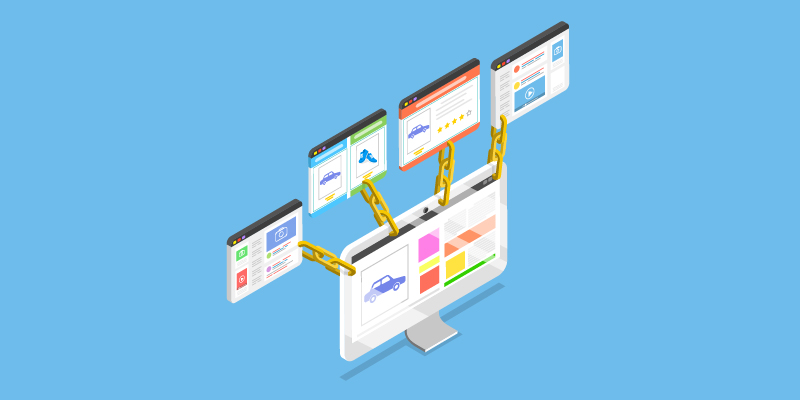
Viv Harries is the Founder of Vivi Creative. He works with businesses to give them the creative edge with unique designs and a solid brand identity.
recent posts
- How a Strong Brand Can Help Welsh Startups Stand Out
- Top 10 Logo Design Mistakes (and How to Avoid Them)
- Web Design Trends of 2025: What’s In, What’s Surprising, and What Actually Works
- Design Trends for 2025
- Maximising Your ROI with Meta and Google Ads in 2025: Best Practices and Our Proven Process

The Power of Backlinks: The Key to SEO Success
In the ever-evolving world of search engine optimization (SEO), one element stands out as a fundamental pillar of success: backlinks. Backlinks play a crucial role in determining a website's authority, visibility, and ranking on search engine results pages (SERPs).
In this blog post, VIVI Creative will explore the significance of backlinks for SEO and unravel why they remain a vital component in the digital landscape.
What are Backlinks?
Backlinks, also known as inbound links or incoming links, are hyperlinks on external websites that direct users to your own site. In simpler terms, they are references from other web pages that link back to your content. These links act as "votes of confidence" from one website to another, indicating to search engines the value and credibility of your content.
The Role of Backlinks in SEO

Enhancing Website Authority and Trust:
Search engines consider backlinks as endorsements or recommendations from other websites. When reputable websites link to your content, it signals to search engines that your site is trustworthy and provides valuable information. Consequently, search engines may reward your site with higher rankings, boosting your visibility and attracting more organic traffic.
Improving Organic Search Rankings:
Backlinks are a crucial factor in search engine algorithms. They help search engines determine the relevance and quality of your content. Websites with a greater number of high-quality backlinks tend to outrank their competitors in organic search results. A well-implemented backlink strategy can help your website climb the rankings ladder, driving more organic traffic to your pages.
Increasing Referral Traffic:
Backlinks not only contribute to higher search engine rankings but also generate referral traffic. When users come across a backlink on another website and click on it, they are redirected to your site. These referral visitors are often pre qualified and interested in your niche or topic, potentially leading to increased engagement, conversions, and revenue.
Enhancing Indexing and Crawling:
Search engine bots utilise backlinks to discover new content and navigate through websites. When a reputable website links to your pages, search engines are more likely to crawl and index your content, ensuring it appears in relevant search results. Backlinks facilitate the indexing process, making it easier for search engines to understand the structure and importance of your site.
Building Relationships and Brand Awareness:
Backlinks can serve as a catalyst for building relationships within your industry or niche. When you collaborate with other website owners or influencers, you can create mutually beneficial opportunities for backlinking. By securing backlinks from authoritative sources, you not only enhance your website's SEO but also raise brand awareness among their audience, fostering credibility and expanding your online reach.
Best Practices for Building Quality Backlinks

Focus on Quality over Quantity:
It's important to prioritise high-quality backlinks over a large number of low-quality ones. Seek out reputable websites that are relevant to your industry and have strong domain authority. A few authoritative backlinks can have a more significant impact on your SEO efforts than numerous low-quality links.
Natural and Organic Link Building:
Avoid manipulative or spammy practices that violate search engine guidelines. Instead, foster natural link building by creating compelling content that naturally attracts backlinks. Engage in guest blogging, influencer outreach, and social media promotion to increase your chances of earning organic backlinks.
Diversify Anchor Text:
Anchor text is the clickable text within a hyperlink. Vary your anchor text to make it appear natural and avoid over-optimisation. Use a mix of branded anchor text, generic phrases, and relevant keywords to create a diverse and natural-looking backlink profile.
Monitor and Disavow Toxic Backlinks:
Regularly monitor your backlink profile using tools like Google
Checking and removing backlinks from your website involves a two-step process:
Backlink Audit:
Performing a backlink audit helps you identify the backlinks pointing to your website and assess their quality. Here's how you can conduct a backlink audit:
1. Utilise Backlink Analysis Tools:
There are several online tools available that can provide insights into your backlink profile. Some popular options include Ahrefs, Moz, SEMrush, and Majestic. These tools allow you to enter your website's URL and generate a detailed report of your backlinks.
2. Analyse Backlink Metrics:
Once you have the backlink report, examine various metrics such as domain authority, page authority, anchor text, referring domains, and spam score. Focus on identifying low-quality or spammy backlinks that could potentially harm your website's SEO.
3. Identify Toxic Backlinks:
Look for backlinks from irrelevant or suspicious websites, link farms, directories, or sites with a high spam score. Pay attention to any links that violate search engine guidelines or seem unnatural.
Backlink Removal:
After identifying problematic backlinks, you should take action to remove them. Here are some steps you can follow:
1. Contact Webmasters:
Reach out to the webmasters of the websites hosting the undesirable backlinks. Politely request the removal of the links, explaining the reasons behind your request. Provide the specific URLs or anchor text of the backlinks to make the process easier for webmasters.
2. Disavow Tool:
If contacting webmasters proves challenging or ineffective, you can use the Google Disavow Links tool. This tool allows you to submit a list of backlinks to Google, informing them that you want those links to be ignored when evaluating your website's rankings. It is important to use the disavow tool with caution and only as a last resort, as it can impact your website's visibility if used incorrectly.
3. Monitor Progress:
Regularly monitor your backlink profile to ensure that the unwanted links are being removed or disavowed successfully. Use the same backlink analysis tools mentioned earlier to check if the toxic backlinks are no longer pointing to your site.
4. Maintain a Healthy Backlink Profile:
Moving forward, focus on building a diverse and natural backlink profile by earning high-quality backlinks from authoritative sources. Create valuable content, engage in guest blogging, collaborate with influencers, and promote your website through social media to attract organic and relevant backlinks.
Remember, the process of backlink removal can take time, and it's important to be patient and persistent. By regularly monitoring your backlinks and taking necessary actions, you can maintain a healthy backlink profile and improve your website's SEO performance.
Thanks for reading


